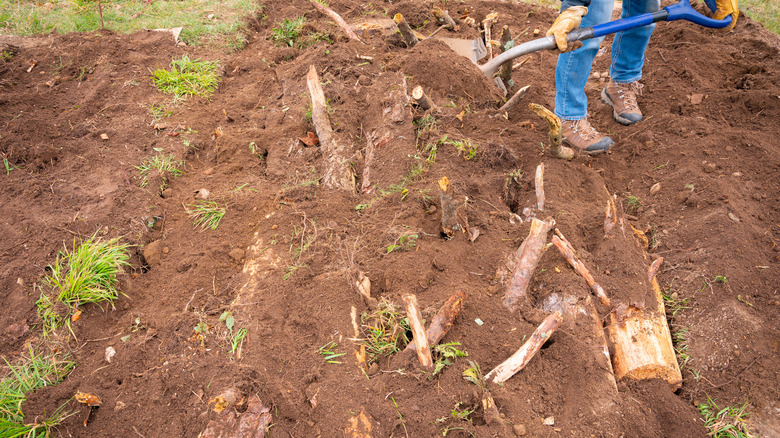The Huge Mistake To Avoid When Planning A Hügelkultur Garden Bed
The gardening method called hügelkultur in German translates literally to "hill culture" in English. The name is an apt representation of how these sustainable mounded garden sites work. They take a little bit of physical effort to get started, but once they're established, you'll have a low-maintenance flower or vegetable bed that remains nutrient-rich for years without having to be tilled at the start of each growing season. Hügelkultur gardens typically begin with a trench. One huge mistake that novice hügelkultur gardeners make is orienting the trench in the wrong direction, thus limiting the amount of sun and water the plants in the finished garden get.
When you're planning the location of the garden, consider the amount of sun the space will receive as you normally would. Most vegetables and many flowers require full sun, while some shade-loving perennials thrive in the type of woodland garden a hügelkultur might complement. But, it's not just the amount of sun you should consider, it's also the orientation. A mound running north to south will have a shady side and a sunny side, but an east-west orientation has even light distribution. Once you've determined the orientation of the garden in relation to the sun, find a site in a slight depression where rain water collects, If possible, and put your hügelkultur garden there. This helps with runoff, and cuts down on the time you spend on irrigation. Additionally, if you have hard-pan subsoil or poor topsoil, a hügelkultur garden will correct this as the organic matter that goes into building it decomposes.
Orienting and building a hügelkultur garden bed
The benefits of building a well-oriented hügelkultur are unbeatable. When you're planning the orientation of the garden, think about the other plants in your landscape. Trees will grow and, left untrimmed, begin to cast shade. Or, if you remove trees, a shady garden might suddenly become sunny. A hügelkultur built on the side of a hill parallel to the direction of runoff might erode and collapse. Ideally, your hügelkultur will be oriented on an east – west axis in a slight depression. If you plan to grow plants that need full sun, make sure there aren't overhanging branches or buildings and fences that could cast shade. Note that you can create a successful hügelkultur on the surface, without digging a trench. The need for proper orientation is just as critical in this situation, but the project is less labor intensive.
Think of your hügelkultur garden as a permanent installation that, when built right, will last for years with a minimum of maintenance. A typical residential hügelkultur trench is 3 feet by 6 feet, but there are no set rules on size. It begins with a trench filled with logs. Smaller branches are interwoven into the logs and topped with leaves and materials you'd use in composting like kitchen waste and grass clippings. The topmost layer of topsoil and mulch are a mounded planting surface. When you're building the hügelkultur, keep in mind that some trees release allelopathic compounds that could be transferred to the vegetables you're growing and affect their growth, germination, and reproduction. Avoid using trees like cottonwood, sycamore, and black walnut for your log base.

